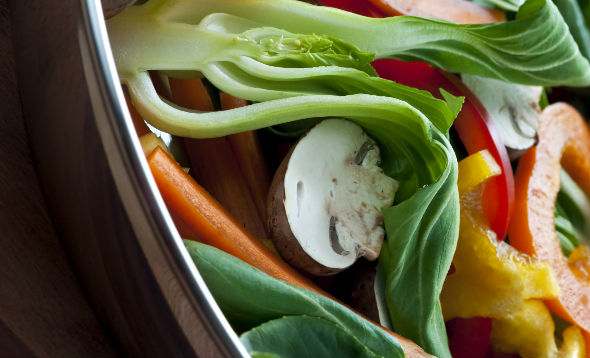That organic living is a conscious health choice
Asian Vegetables
Whether you’re concerned with your children’s growth and development, managing ailments, maintaining your health or enhancing your longevity – vegetables deserve priority placement on your platter.
In Singapore, where most foods are imported, it’s easy – and perhaps intriguing - to reach for produce from far abroad. Consider purchasing locally-grown greens instead. Local produce is fresher, healthier and tastier, as it spends less time in transit from farm to table, thus making it more nutrient-dense as well.
Many vegetables native to Asia naturally possess combinations of fibre, essential vitamins and minerals, and phytochemicals unrivalled by their Western counterparts. Here are a few to drop in the basket on your next visit to the market:
Lotus
The flesh of this vegetable has a delicate flavour that is mild and sweet, similar to water chestnut or jicama. As with all root vegetables, the carbohydrate derived from the lotus is primarily starch.
However, compared to others like the potato, the lotus has twice as much fibre – making it an ideal replacement for individuals hoping to control blood sugar levels or promote digestive health. In traditional Chinese medicine, lotus root is often used to alleviate gastrointestinal distress and diarrhoea. Its natural sodium to potassium ratio is considered the ideal electrolyte balance for blood pressure control. Don’t be too quick to judge the lotus by its colour - or lack thereof, though. This veggie packs in multiple essential minerals such as copper, iron, and zinc, and almost 75 per cent of the recommended daily intake of vitamin C, when eaten fresh.
So, how should lotus be eaten? Raw lotus root is a great crunchy addition to any salad. For a healthy snack, slice it thinly, lightly bake it and you’ll have crisp chips, perfect when you’re feeling peckish. Or include as you would with any other starchy vegetable - into a curry, soup or stir-fry.
Asia has a wealth of cabbage varieties – like napa or bok choy – in a multitude of colours and sizes. While many think that cabbage is a ‘leafy’ green, it’s actually a member of the cruciferous vegetable family – alongside broccoli and cauliflower.
While cabbage may not receive the same attention as its peers, it shares many of their health benefits. Sulphur-rich cabbage promotes liver detoxification and even guards against radiation damage. It also contains apigenin, a potent anti-cancer bioflavonoid that inhibits the growth of cancer cells. Its high water and fibre content is ideal for promoting digestion and improving regularity. When fermented - as in kimchi or sauerkraut - cabbage serves as a valuable vegan, dairy-free probiotic source. And with less than 20 calories per 75-gramme serving, this veggie fits easily into any weight loss diet. Cabbage works well in cold or warm dishes, and serves as the perfect low-carb replacement for potsticker wrappers or wonton skins. Important reminder: watch your cooking timer, as its notorious odour only appears when it is over-cooked.
Pea shoots
Pea shoots are a playful departure from the popular bean sprout. These are literally the mini-greens that sprout from green peas – and they share the same sweet flavour. Despite their petite size and barely-there weight, pea shoots are packed with micronutrients – vitamin C, beta-carotene and folic acid. They also contain a generous helping of chlorophyll, which is valuable for binding and clearing toxins in the intestinal tract before they enter the circulatory system.
Best of all, there’re endless ways to eat this versatile vegetable. Toss in fresh salads and tuck into sandwiches. Wilt into warm dishes like soups and pastas, or stir into sauces or marinades. But use them as soon as you can, as these little ones stay fresh for just one to two days.
Gai Lan (or Kai Lan) is also referred to as Chinese broccoli or kale, and you can liken its appearance to a cross between the two. Gai Lan is readily available and relatively less costly as compared to kale or broccoli, for consumers here in the East. In fact, many appreciate its delicate leaves and milder flavour as a happy medium between its two peers. While not as concentrated as its western counterparts, Gai Lan also contains mustard oils (called isothiocyanates) that support liver function and promote the cleansing of bloodstream. It is rich in vitamin K, known for its importance in preventing blood clots but recently valued for its role in bone integrity.
There’s truly no limit to Gai Lan’s uses – side dishes, stir-fries or stews. However buying organic and avoiding over mature leaves lends a softer, milder taste - rather than bitter notes - to all recipes.
White, button, and portobello mushrooms, previously hogged the spotlight in the West. However, these fungi have taken a back seat now that scientific evidence has proven the potent medicinal properties of Asian mushrooms.
Shiitake, shimeji, maitake and lion’s mane mushrooms – traditionally used in Asian cuisine – are now hot ticket items in grocery stores worldwide. Each species boasts unique benefits - from controlling cholesterol and blood sugar levels, fighting infectious microbes, reducing inflammations, alleviating joint pains, to warding off damaging free radicals.
To avoid heavy metals and harmful toxins, opt for organic fungi and avoid eating them raw. Dried mushrooms come in handy when fresh ones are not in season. As for culinary applications, the only limitation is your creativity. Authentic Asian mushroom dishes lean toward soups, stews and stir-fried mixed vegetables.
Daikon
Believe it or not, this humble colourless radish – often overlooked and used as a mere garnish – has much to brag about. While its seeds are used in Eastern medicine for cardiovascular support and as a remedy for digestive ailments, its roots bring their own nutrition perks to the kitchen. Widely used in Japan, China, Korea and the Philippines, the daikon root can be served pickled, dried, raw, boiled, infused in teas or even juices. Its inherent diuretic properties alleviate fluid retention and swelling. Food scientists recently discovered the same enzymes from the human digestive tract in daikon juice – explaining its long-held role as a soothing accompaniment to heavier Asian dishes.
What’s more, the phenolic compounds in uncooked daikon are anti-inflammatory and rich in antioxidants. Resembling a white carrot, this root vegetable pairs well with or can be used as a substitute for its orange-coloured twin. Relish this radish in myriad ways – in a creamy slaw, hearty stew, healthy salad or comforting soup.


























_1672804154.jpg)

_1611290459.jpg)